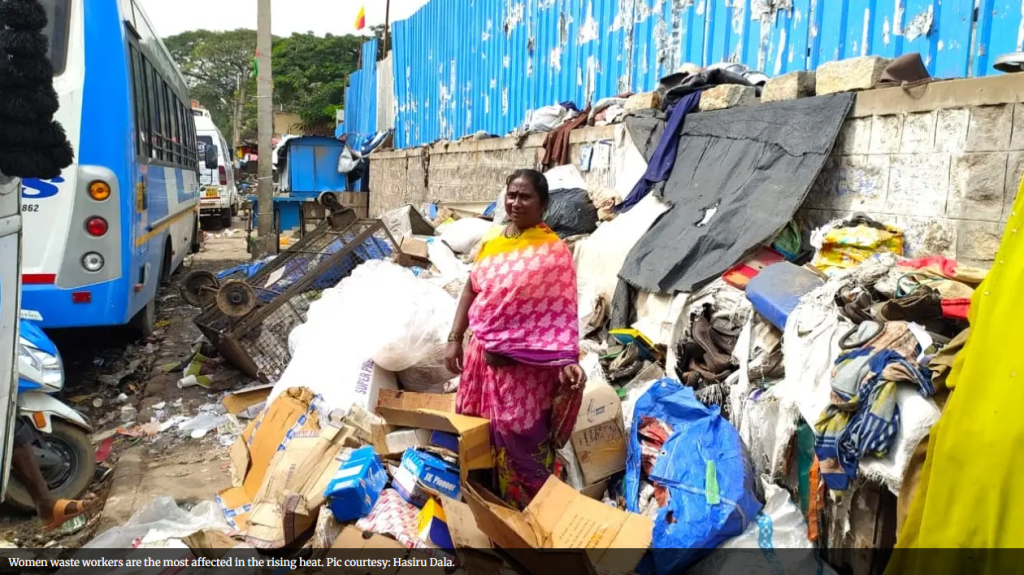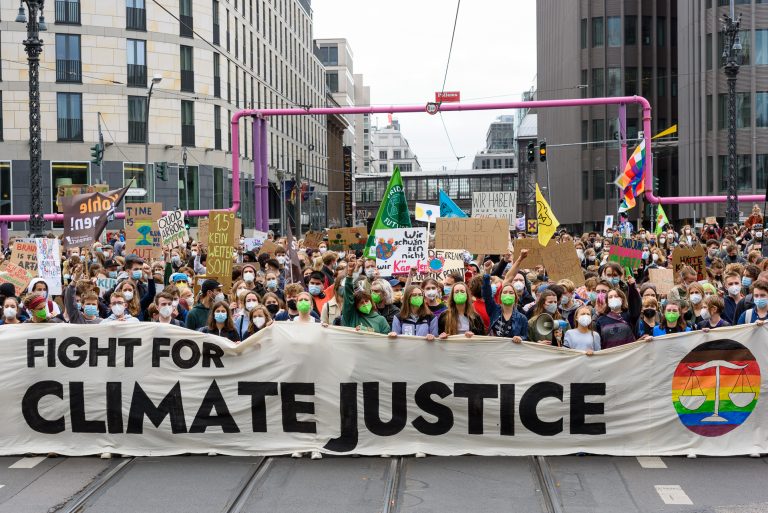Women waste pickers face the worst heat impacts due to health and economic challenges. Insurance and affordable healthcare can help.
Thirty-year-old Yallamma Shankar migrated to Bengaluru from Koppal district in northern Karnataka 14 years ago. She settled in Sumannahalli, in the western part of the city, and took up free-roaming waste work to make ends meet. Initially, she was glad to work outdoors in a city known for its good weather. Every day, she left her home at 5 am and worked till 2 pm, walking up to 10 kilometres a day to collect waste.
“But in the last decade, summers have become unbearable. I feel giddy, dehydrated, and often lose three days of work each month because I fall sick due to the heat,” says Yallamma. She is her family’s sole breadwinner, supporting her disabled husband and three children.
Yallamma is one of 25,000 waste pickers working in Bengaluru’s formal and semi-formal waste systems. These workers play a vital role in the city’s circular economy by diverting waste from landfills, cutting greenhouse gas emissions, and reducing municipal costs. Yet, despite their climate contributions, they remain vulnerable to rising temperatures, with minimal institutional support.
Waste work in the city is profoundly shaped by gender and caste, with 63.6% women and 60% from SC/ST communities. These workers already face major social and economic disadvantages. Now, with land surface temperatures increasing by 15.13 °C over the past three decades, extreme heat is making it even harder to earn a living and stay healthy.
Impact of heat on waste workers
A recent study by HeatWatch and Hasiru Dala, titled ‘Rising Heat and Waste Workers’, surveyed 154 waste workers in Bengaluru and highlighted the severe impact of rising heat on the city’s solid waste workforce. The study identifies three groups: municipally employed pourakarmikas, dry waste collection centre (DWCC) staff, and free-roaming waste pickers. The research reveals that the last two categories of workers are often the most vulnerable, as they are exposed to heat at peak hours and lack fixed incomes.
 Source: HeatWatch and Hasiru Dala. Pic: Vinod Sebastian for Saamuhika Shakti. Infographic: Sahana Charan/Bhanu Sridharan.
Source: HeatWatch and Hasiru Dala. Pic: Vinod Sebastian for Saamuhika Shakti. Infographic: Sahana Charan/Bhanu Sridharan.
“Our work is already physically demanding, and now the heat adds another dimension of difficulty to it. Fevers and body pain have become my constant companions on hot days,” says Yallamma.
On February 17, 2025, Bengaluru recorded a temperature of 35.9°C, making it the city’s hottest February day in two decades.
Around the week this record was made, 37-year-old Alamelu, a widow, nearly fainted on her way back home to Katriguppe in the southern part of Bengaluru, after a long day of collecting recyclables from Padma Nagar, Arohalli and Kanta Bazaar. Like most free-roaming waste workers, her days start at around 6 am, and it is 3 pm before she can return home.
“On very hot days, thirst and fatigue make collecting waste a struggle. I try to rest under a tree, but these days the number of trees on main roads has become less,” says Alamelu, who has been a waste worker since the age of 10.
Heat, health and gender dynamics
Her observations align with a 26% decline in Bengaluru’s green cover over 50 years, which, coupled with rapid urbanisation, has dangerously increased land surface temperatures. “My entire body was burning, and I had developed a splitting headache. I had just about spotted a tree when I collapsed. Nobody comes to our aid in such situations,” she adds.

With Bengaluru now consistently witnessing early summers, waste workers find themselves subject to its impacts for more days and longer durations. Even DWCC workers who would seem more protected due to the availability of indoor seating, venture outdoors given the lack of ventilation in the collection centres that are covered with tin or asbestos roofs.
55-year-old Kumudha, a resident of Katriguppe, travels by bus every day to JP Nagar to one such collection centre. After spending 11 years as a free-roaming waste picker, she became a DWCC operator in 2015 and employs 25 people daily to sort waste, of which 17 are women. They work from 9 am to 5 pm every day, which includes hours of peak heat. Any notions she may have had of a more comfortable workplace setting in a collection centre have dissipated in the last three years.
“On most summer days, the centre feels like an oven, so we move outside under a tarpaulin sheet to do the sorting,” she explains. “We don’t have electricity or running water. The women who work here don’t even eat lunch because their appetites are affected by the heat. They work through the day on just one meal and fill their stomachs with water, buttermilk and cool drinks. Dizziness and even seeing black spots is common. Before the women faint I ensure they get some water or rest,” she adds.
Loss of productivity
Over the past decade, productivity in the summer has declined, with women over 50 quitting due to harsh conditions and younger women frequently missing work due to health issues and lack of basic amenities.
“The women who work for me don’t do this job because they enjoy it. They have no other skill, and in most cases their husbands are either dead, alcoholics or disabled. Their next meal depends on the wages they make that day. If they choose to take leave or quit coming here, you can imagine the level of discomfort they face,” she explains.
On the roads, meanwhile, multiple free-roaming waste workers admitted to consuming less water and purposely avoiding eating, so that the need to use a bathroom doesn’t arise. Only 39.6% of surveyed waste workers had access to clean drinking water, and just 13% to clean washrooms; women were disproportionately excluded.
“When there are no toilets, we are forced to relieve ourselves in open fields. Homeowners harass and berate us for dirtying the area,” admits Alamelu. “I have urinary tract infections (UTIs) very often. This summer, I was too unwell to work for three weeks,” she adds.
But acknowledging heat stress and exhaustion rarely translates to getting medical help. Waste workers rarely go to primary health centres if they are not within walking distance, and avoid private medical centres, fearing high treatment costs.
“I just ask the pharmacist for medicines. I worry about where the money for my next meal is coming from. Where is the question of getting medical treatment?” asks Alamelu.
Economic losses
Pourakarmikas, who are formally employed, earn above ₹4,500 per week, while informal workers earn below ₹3,500. Free-roaming waste pickers earn the lowest wages despite working the most hours and walking the longest distances.

These losses add to rising household and medical expenses, pushing workers into deeper precarity. 94% of workers surveyed noted increased costs for food and water, 86% for fans or coolers, and an average medical expense of ₹1,196 per month for heat-related illness.
“I spend close to ₹1000 a month just for medicines, hydrating drinks and Pay-and-Use toilets,” says Ahnumaya D, a free-roaming waste worker from Sumanahalli.
For Kumudha meanwhile, summers mean a worrying escalation in operating costs.
She usually earns up to ₹25,000 a month after paying wages and other operating costs. In summer, however, her profits plummet to about ₹15,000.
“I spend at least an additional ₹6000 on water, cool drinks and other hydration aids,” she explains. “But the real concern lies in the drop in productivity. There are more breaks because we get tired faster, and there are more absences. If I have 25 people coming usually, it falls to 15 during the summer,” she adds.
Advisories from the state government asking workers to pause work during peak hours often doesn’t work when it comes to women waste workers.
“Women waste workers have to do unpaid domestic and care responsibilities at home as well, which includes cooking and childcare,” says Geetanjali Sharma from Hasiru Dala. “So, pausing is not preferred because they want to finish their work and go home. For some informal waste worker categories, pausing work can also affect the money they are able to make. Moreover, there are limited spaces for rest, especially for free-roaming waste workers.”
What then can be done to mitigate the growing heat stress these outdoor workers are facing?
What workers want
- Access to clean drinking water and bathrooms
- Fixed wages and insurance to protect against lost work days
- Medical support for symptoms of heat stress
Recommendations
Expansion of Employee State Insurance Corporation (ESIC) coverage for instance, the report recommends, could resolve concerns regarding affordable and accessible healthcare facilities for outdoor informal workers
“For waste workers, the need is to urgently expand ESIC to cover climate-induced ailments and be inclusive of those without formal employment contracts. This would enable direct access to affordable healthcare and reduce out-of-pocket spending on treatments related to heat stress, as the report shows workers spend over ₹1,000 monthly on health expenses,” says Apekshita Varshney, the Founder of HeatWatch.
“The state and employers could introduce parametric insurance alongside ESIC as a complementary measure to protect wages and income during extreme heat events. Together, these tools can build a layered resilience framework,” she adds.
Another important and implementable solution would be to improve the existing DWCC infrastructure. “By ensuring electricity and water access is available, these centres can become resting spaces for not just waste workers but can also benefit other outdoor workers,” says Geethanjali Sharma, a research associate at Hasiru Dala. Bengaluru currently has over 160 DWCCs.
Till December 2024, the Bruhat Bengaluru Mahanagara Palike was supporting DWCCs by providing infrastructure for sorting and baling. It was also responsible for ensuring sanitation facilities such as toilets and water connections. Currently, limited facilities have access to electricity and water connections.
At a policy level meanwhile, the problems are deeper.
There is an absence of disaggregated data to help understand how vulnerability varies according to the specific type of outdoor work and its intersection with gender and caste. Further, Bengaluru’s heat mitigation strategies are part of the wider Bengaluru Climate Action Plan (BCAP) and the city doesn’t have a separate plan to tackle heat for outdoor workers.
“The funding mechanisms outlined in BCAP’s existing sectoral actions remain suggestive in nature, with recommendations such as developing a climate budget or aligning existing departmental implementation with climate action to attract private sector funding. This limits clarity on what actions can and will be taken up, by whom, and most importantly, how effective and relevant they will be for outdoor workers’ contexts,” adds Geethanjali.
Response from BSWML on benefits for waste workers
When Citizen Matters asked BSWML about plans to support waste workers, it became clear that heat stress wasn’t a priority. Still, the department was willing to learn and adapt.
“We are so far not completely aware of the impact of heat on waste workers,” admits Karee Gowda, Chief Executive Officer (CEO) of BSWML. “We have to study the problem first and then plan for any measures we can take,” he adds.
There are no plans to expand ESIC coverage for informal waste workers. However, DWCCs are set for an upgrade. “A tri-party agreement among the DWCC supervisor, a non-governmental organisation and contractors who collect waste, will be signed shortly. It will also look into improving DWCCs,” he adds.
Source link : View Article
Author
-

Priyanka Thirumurthy is an award-winning multimedia journalist with a focus on the impact of climate change and excessive heat on our everyday lives



